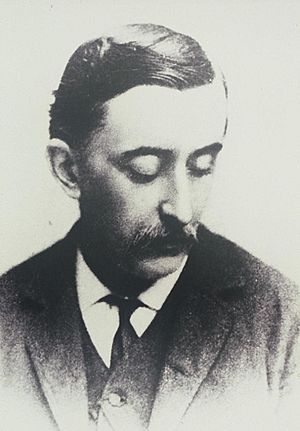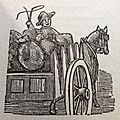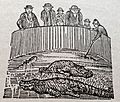Lafcadio Hearn facts for kids
Quick facts for kids
Lafcadio Hearn
Koizumi Yakumo (小泉八雲) |
|
|---|---|

Lafcadio Hearn in 1889 by Frederick Gutekunst
|
|
| Born | Patrick Lafcadio Hearn; Πατρίκιος Λευκάδιος Χερν 27 June 1850 Lefkada, United States of the Ionian Islands |
| Died | 26 September 1904 (aged 54) Tokyo, Japan |
| Pen name | Koizumi Yakumo |
| Language | English, Greek, Japanese |
| Nationality | Irish, Greek, Japanese |
| Alma mater | Ushaw College, University of Durham, England |
| Spouse | Alethea ("Mattie") Foley Koizumi Setsu |
Patrick Lafcadio Hearn ( Greek: Πατρίκιος Λευκάδιος Χερν; 27 June 1850 – 26 September 1904) was a writer. People know him for his books about Japan, especially his collections of Japanese legends and ghost stories, such as Kwaidan: Stories and Studies of Strange Things. In the United States, Hearn also wrote about the city of New Orleans. He also used the Japanese name Koizumi Yakumo (小泉 八雲)
Contents
Life
Early life
Hearn was born in and named after the island of Lefkada, one of the Greek Ionian Islands, on 27 June 1850. He was the son of Surgeon-Major Charles Bush Hearn (of County Offaly, Ireland) and Rosa Antoniou Kassimatis, a Greek woman.
Emigration to Ireland, abandonment
A complex series of conflicts and events led to Lafcadio Hearn being moved from Greece to Ireland, where he was abandoned first by his mother (leaving him in the care of her husband's aunt), then his father, and finally by his father's aunt, who had been appointed his official guardian.
In 1857, he was seven years old. Both his parents were still alive, but his great aunt, Sarah Brenane, took care of him. Hearn began exploring Brenane's library and read a lot of Greek literature, especially myths.
Catholic education, abandonment
In 1861, Hearn's aunt sent him to the Institution Ecclésiastique, a Catholic church school in Yvetot, France. Hearn learned to dislike Catholic education. Hearn became fluent in French and would later translate into English the works of Guy de Maupassant, who coincidentally attended the school shortly after Hearn's departure.
In 1863, entered St. Cuthbert's College, Ushaw, a Catholic seminary at what is now the University of Durham. At age 16, Hearn injured his left eye in a schoolyard accident. The eye became infected. He left school for one year. He became blind in that eye. Hearn also myopia, so he had poor vision for the rest of his life. Hearn was embarrassed by his appearance, so he covered his left eye.
In 1867, Henry Molyneux, who had become Sarah Brenane's financial manager, went bankrupt, along with Brenane. There was no money for tuition, and Hearn was sent to London's East End to live with Brenane's former maid. She and her husband had little time or money for Hearn, who wandered the streets, spent time in workhouses, and generally lived an aimless, rootless existence. His main intellectual activities consisted of visits to libraries and the British Museum.
Emigration to Cincinnati
By 1869, Henry Molyneux had some money. He bought Hearn a one-way ticket to New York and told him to go to Cincinnati, find Molyneux's sister and her husband, Thomas Cullinan, and ask them for help. Cullinan gave him $5 and wished him luck. He was very poor and lived in stables or store rooms in exchange for hard work.
New Orleans
Hearn lived in New Orleans for nearly a decade. He worked for several newspapers and magazines. He also translated the French author Gautier into English. Hearn also published in Harper's Weekly the first known written article (1883) about Filipinos in the United States, the Manilamen or Tagalogs, one of whose villages he had visited at Saint Malo, southeast of Lake Borgne in St. Bernard Parish, Louisiana.
Two Years in the French West Indies
Harper's sent Hearn to the West Indies as a correspondent in 1887. He spent two years in Martinique, He wrote for the magazine and wrote two books: Two Years in the French West Indies and Youma, The Story of a West-Indian Slave, both published in 1890.
Later life in Japan
In 1890, Hearn went to Japan as a newspaper correspondent. In Japan, he found a home and his greatest inspiration. Basil Hall Chamberlain helped Hearn get a teaching job during the summer of 1890 at the Shimane Prefectural Common Middle School and Normal School in Matsue. The Lafcadio Hearn Memorial Museum and his old home are still two of Matsue's most popular tourist attractions. In Matsue, Hearn married Koizumi Setsu, the daughter of a local samurai family. They had four children together. He became a naturalized Japanese and changed his name to Koizumi Yakumo, in 1896. He followed many religions: first Greek Orthodox, then Roman Catholic, and, later on, Spencerian. Finally, he became Buddhist.
During late 1891, Hearn started teaching in Kumamoto, Kyūshū, at the Fifth Higher Middle School. He worked there for three years and completed his book Glimpses of Unfamiliar Japan (1894). In October 1894, he got a job as a journalist with the English-language newspaper Kobe Chronicle. In 1896, he began teaching English literature at Tokyo Imperial University. He taught there until 1903. In 1904, he became a professor at Waseda University.
On 26 September 1904, he died of heart failure. He was 54 years old. His grave is at the Zōshigaya Cemetery in Toshima, Tokyo.
In the late 19th century, Westerners knew little about Japan. However, the Exposition Universelle of 1900 made Japanese styles fashionable in Western countries. So, Hearn became well-known because of his books about Japan. Later, some critics said Hearn made Japan seem too exotic. But, he gave the West some of its first descriptions of pre-industrial and Meiji Era Japan, so his work has value.
Works
Books by Hearn about Japan
Source:
- Glimpses of Unfamiliar Japan (1894)
- Out of the East: Reveries and Studies in New Japan (1895)
- Kokoro: Hints and Echoes of Japanese Inner Life (1896)
- Gleanings in Buddha-Fields: Studies of Hand and Soul in the Far East (1897)
- The Boy who Drew Cats, (1897)
- Exotics and Retrospectives (1898)
- Japanese Fairy Tales (1898, and sequels)
- In Ghostly Japan (1899)
- Shadowings (1900)
- Japanese Lyrics (1900)
- A Japanese Miscellany (1901)
- Kottō: Being Japanese Curios, with Sundry Cobwebs (1902)
- Kwaidan: Stories and Studies of Strange Things (1903, later made into the movie Kwaidan by Masaki Kobayashi)
- Japan: An Attempt at Interpretation (1904)
- The Romance of the Milky Way and other studies and stories (1905)
Books by Hearn about Louisiana
- La Cuisine Creole: A Collection of Culinary Recipes (1885)
- Gombo Zhèbes": A Little Dictionary of Creole Proverbs, Selected from Six Creole Dialects. (1885)
- Chita: A Memory of Last Island (1889)
- Creole Sketches (1924, Houghton Mifflin)
Other
- One of Cleopatra's Nights and Other Fantastic Romances (1882, translation of stories by Théophile Gautier), Richard Worthington
- Stray Leaves From Strange Literature; Stories Reconstructed from the Anvari-Soheili, Baital Pachisi, Mahabharata, Pantchantra, Gulistan, Talmud, Kalewala, etc.(1884, James R. Osgood and Company)
- Some Chinese Ghosts (1887)
- Youma, the Story of a West-Indian Slave (1889)
- Two Years in the French West Indies (1890)
- Amenomori, Nobushige (1905). "Lafcadio Hearn, the Man," The Atlantic Monthly, October 1905.
- Bisland, Elizabeth (1906). The Life and Letters of Lafcadio Hearn, Vol. II, New York: Houghton, Mifflin & Company.
- .
- .
- Dawson, Carl (1992). Lafcadio Hearn and the Vision of Japan, Johns Hopkins University Press.
- .
- .
- .
- .
- Kunst, Arthur E. (1969). Lafcadio Hearn, Twayne Publishers.
- Langton, D. H. (1912). "Lafcadio Hearn: Journalist and Writer on Japan," The Manchester Quarterly, Vol. XXXI.
- .
- Mais, S. P. B. (1920). "Lafcadio Hearn." In Books and their Writers, Grant Richards, Ltd.
- McWilliams, Vera (1946). Lafcadio Hearn, Houghton Mifflin Company.
- Miner, Earl Roy (1958). The Japanese Tradition in British and American Literature, Princeton University Press.
- Monaham, Michael (1922). "Lafcadio Hearn," An Attic Dreamer, Mitchell Kennerley.
- More, Paul Elmer (1905). "Lafcadio Hearn." In Shelburne Essays, Second Series, G. P. Putnam's Sons.
- .
- Noguchi, Yone (1905). "Lafcadio Hearn, A Dreamer," National Magazine, Vol. XXII, No. 1.
- .
- .
- .
- ; republished in .
- Setsu, Koizumi (1918). Reminiscences of Lafcadio Hearn, Houghton Mifflin Company.
- Savina, Zoe. "The Golden Book" Dedicated to Lafcadio Hearn. Haiku Poems and Collages. July 2014
Trilingual Book: Greek, English tr. Constantine Fourakis, Japanese tr. Ban'ya Natsuishi
- .
- Thomas, Edward (1912). Lafcadio Hearn, Houghton Mifflin Company.
- .
- .
- .
Images for kids
-
Plaque on Hearn's home on Gardiner Street, Dublin
-
Hearn's former home on Cleveland Avenue in New Orleans is preserved as a registered historic place.
See also
 In Spanish: Lafcadio Hearn para niños
In Spanish: Lafcadio Hearn para niños










